United States Colored Troops
The United States Colored Troops (USCT) were regiments in the United States Army composed primarily of African-American (colored) soldiers, although members of other minority groups also served with the units. They were first recruited during the American Civil War, and by the end of that war in April 1865, the 175 USCT regiments constituted about one-tenth of the manpower of the Union Army. About 20% of USCT soldiers died, a rate about 35% higher than that of white Union troops. Despite heavy casualties, many fought with distinction, 15 USCT soldiers receiving the Medal of Honor and numerous others receiving other honors.
| USCT | |
|---|---|
| United States Colored Troops | |
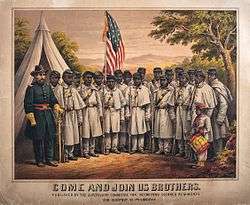 USCT recruiting poster | |
| Active | May 22, 1863 – Oct 1865 |
| Disbanded | October 1865 |
| Allegiance | Union |
| Branch | Army |
| Type | infantry, cavalry, artillery, engineering |
| Size | 175 regiments; 178,000 men |
| Motto(s) | Sic semper tyrannis |
| Engagements | American Civil War |
The USCT regiments were precursors to the Buffalo Soldier regiments in the American Old West.
History
The Confiscation Act
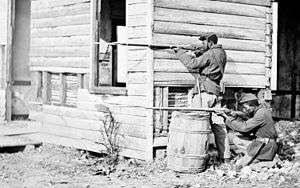
The U.S. Congress passed the Confiscation Act of 1862[1] in July 1862. It freed slaves whose owners were in rebellion against the United States, and the Militia Act of 1862 empowered the President to use former slaves in any capacity in the army. President Abraham Lincoln was concerned with public opinion in the four border states that remained in the Union, as they had numerous slaveholders, as well as with northern Democrats who supported the war but were less supportive of abolition than many northern Republicans. Lincoln opposed early efforts to recruit African-American soldiers, although he accepted the Army using them as paid workers. Native Americans also played a significant role in the colored regiments of the American Civil War. In September 1862, Lincoln issued his preliminary Emancipation Proclamation, announcing that all slaves in rebellious states would be free as of January 1. Recruitment of colored regiments began in full force following the Proclamation in January 1863.[2]
The United States War Department issued General Order Number 143 on May 22, 1863, establishing the Bureau of Colored Troops to facilitate the recruitment of African-American soldiers to fight for the Union Army.[3] These units became known as the United States Colored Troops (USCT), although other people of color who were not of African descent, such as Native Americans, Pacific Islanders, and Asian Americans also fought under USCT regiments and made significant contributions.[4][5] Regiments, including infantry, cavalry, engineers, light artillery, and heavy artillery units were recruited from all states of the Union.
Approximately 175 regiments comprising more than 178,000 free blacks and freedmen served during the last two years of the war. Their service bolstered the Union war effort at a critical time. By war's end, the men of the USCT made up nearly one-tenth of all Union troops.
The USCT suffered 2,751 combat casualties during the war, and 68,178 losses from all causes. Disease caused the most fatalities for all troops, both black and white.[6] In the last year-and-a-half and from all reported casualties, approximately 20% of all African Americans enrolled in the military lost their lives.[7] Notably, their mortality rate was significantly higher than white soldiers:
[We] find, according to the revised official data, that of the slightly over two millions troops in the United States Volunteers, over 316,000 died (from all causes), or 15.2%. Of the 67,000 Regular Army (white) troops, 8.6%, or not quite 6,000, died. Of the approximately 180,000 United States Colored Troops, however, over 36,000 died, or 20.5%. In other words, the mortality rate amongst the United States Colored Troops in the Civil War was thirty-five percent greater than that among other troops, notwithstanding the fact that the former were not enrolled until some eighteen months after the fighting began.
USCT regiments were led by white officers, while rank advancement was limited for black soldiers. The Supervisory Committee for Recruiting Colored Regiments in Philadelphia opened the Free Military Academy for Applicants for the Command of Colored Troops at the end of 1863.[8] For a time, black soldiers received less pay than their white counterparts, but they and their supporters lobbied and eventually gained equal pay.[9] Notable members of USCT regiments included Martin Robinson Delany and the sons of abolitionist Frederick Douglass.
The USCT engineers built Fort Pocahontas, a Union supply depot, in Charles City, Virginia.[10]
The courage displayed by colored troops during the Civil War played an important role in African Americans gaining new rights. As Frederick Douglass wrote:
Once let the black man get upon his person the brass letter, U.S., let him get an eagle on his button, and a musket on his shoulder and bullets in his pocket, there is no power on earth that can deny that he has earned the right to citizenship.[11]
Volunteer regiments
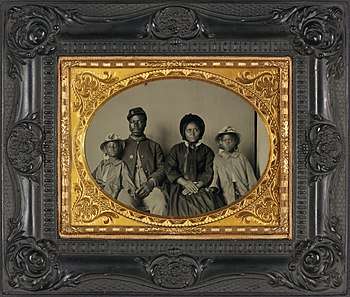

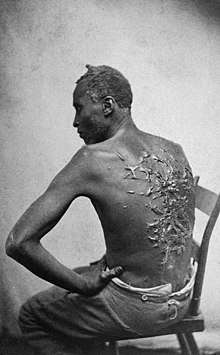
Before the USCT was formed, several volunteer regiments were raised from free black men, including freedmen in the South. In 1863 a former slave, William Henry Singleton, helped recruit 1,000 former slaves in New Bern, North Carolina for the First North Carolina Colored Volunteers. He became a sergeant in the 35th USCT. Freedmen from the Roanoke Island Freedmen's Colony, established in 1863 on the island, also formed part of the Free North Carolina Colored Volunteers (FNCCV) and subsequently the 35th.[13] Nearly all of the volunteer regiments were converted into USCT units.
In 1922 Singleton published his memoir (in a slave narrative) of his journey from slavery to freedom and becoming a Union soldier. Glad to participate in reunions, years later at the age of 95, he marched in a Grand Army of the Republic (GAR) event in 1938.
State volunteers
Four regiments were considered Regular units, rather than auxiliaries. Their veteran status allowed them to get valuable federal government jobs after the war, from which African Americans had usually been excluded in earlier years. However, the men received no formal recognition for combat honors and awards until the turn of the 20th century.
These units were:
- 5th Regiment Massachusetts Colored Volunteer Cavalry
- 54th Massachusetts (Colored) Volunteer Infantry Regiment
- 55th Massachusetts (Colored) Volunteer Infantry Regiment
- 29th Connecticut (Colored) Volunteer Infantry Regiment
- 30th Connecticut Volunteer Infantry Regiment
- 31st Infantry Regiment (Colored)
Corps d'Afrique
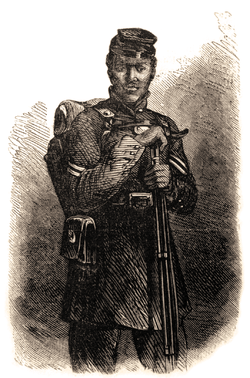
The Corps d'Afrique, one of many Louisiana Union Civil War units, was formed in New Orleans after the city was taken and occupied by Union forces. It was formed in part from the Louisiana Native Guards. The Native Guards were former militia units raised in New Orleans, who were property-owning free people of color (gens de couleur libres).[14]
Free mixed-race people had developed as a third class in New Orleans since the colonial years. During the Civil War, many free men of color wanted to prove their bravery and loyalty to the Confederacy like other Southern property owners by joining militias such as the 1st Louisiana Native Guard (CSA), but the Confederacy did not allow them to serve and confiscated the arms of those in the militia.
For later units of the Corps d'Afrique, the Union recruited freedmen from the refugee camps. Liberated from nearby plantations, they and their families had no means to earn a living and no place to go. Local commanders, starved for replacements, started equipping volunteer units with cast-off uniforms and obsolete or captured firearms. The men were treated and paid as auxiliaries, performing guard or picket duties to free up white soldiers for maneuver units. In exchange their families were fed, clothed and housed for free at the Army camps; often schools were set up for them and their children.
Despite class differences between free people of color and freedmen, the troops of the Corps d'Afrique served with distinction, including at the Battle of Port Hudson and throughout the South. Its units included:
- 4 Regiments of Louisiana Native Guards (renamed the 1st–4th Corps d'Afrique Infantry, later renamed as the 73rd–76th US Colored Infantry on April 4, 1864).
- 1st and 2nd Brigade Marching Bands, Corps d'Afrique (later made into Nos. 1 and 2 Bands, USCT).
- 1st Regiment of Cavalry (1st Corps d'Afrique Cavalry, later made into the 4th US Colored Cavalry).
- 22 Regiments of Infantry (1st–20th, 22nd, and 26th Corps d'Afrique Infantry, later converted into the 77th–79th, 80th–83rd, 84th–88th, and 89th–93rd US Colored Infantry on April 4, 1864).
- 5 Regiments of Engineers (1st–5th Corps d'Afrique Engineers, later converted into the 95th–99th US Colored Infantry regiments on April 4, 1864) whose work building Bailey's Dam saved the Union navy's Mississippi River Squadron.
- 1 Regiment of Heavy Artillery (later converted into the 10th US Colored (Heavy) Artillery on May 21, 1864).
Right Wing, XVI Corps (1864)
Colored troops served as laborers in the 16th Army Corps' Quartermaster's Department and Pioneer Corps.
- Detachment, Quartermaster's Department.
- Pioneer Corps, 1st Division (Mower), 16th Army Corps.
- Pioneer Corps, Cavalry Division (Grierson), 16th Army Corps.
USCT Regiments
- 6 Regiments of Cavalry [1st–6th USC Cavalry]
- 1 Regiment of Light Artillery [2nd USC (Light) Artillery]
- 1 Independent USC (Heavy) Artillery Battery
- 13 Heavy Artillery Regiments [1st and 3rd–14th USC (Heavy) Artillery]
- 1 unassigned Company of Infantry [Company A, US Colored Infantry]
- 1 Independent USC Company of Infantry (Southard's Independent Company, Pennsylvania (Colored) Infantry)
- 1 Independent USC Regiment of Infantry [Powell's Regiment, US Colored Infantry]
- 135 Regiments of Infantry [1st–138th USC Infantry] (The 94th, 105th, and 126th USC Infantry regiments were never fully formed)
- Details
- The 2nd USC (Light) Artillery Regiment (2nd USCA) was made up of nine separate batteries grouped into three nominal battalions of three batteries each. The batteries were usually detached.
- I Battalion: A,B & C Batteries.
- II Battalion: D, E & F Batteries.
- III Battalion: G, H & I Batteries.
- The second raising of the 11th USC Infantry (USCI) was created by converting the 7th USC (Heavy) Artillery into an infantry unit.
- The second raising of the 79th USC Infantry (USCI) was formed from the 1st Kansas Colored Infantry.
- The second raising of the 83rd USC Infantry (USCI) was formed from the 2nd Kansas Colored Infantry.
- The second raising of the 87th USCI was formed from merging the first raisings of the 87th and 96th USCI.
- The second raising of the 113th USCI was formed by merging the first raisings of the 11th, 112th, and 113th USCI.
.png) 3rd US Colored Troops banner {obverse}
3rd US Colored Troops banner {obverse}.png) 3rd US Colored Troops banner [Reverse]
3rd US Colored Troops banner [Reverse]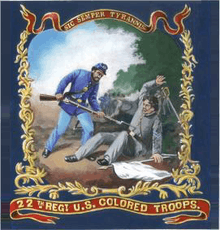 Banner of the 22nd Regiment of the USCT, depicting a black U.S. soldier bayoneting a Confederate under the title "Sic Sempter Tyrantus" (Ever thus to Tryants)
Banner of the 22nd Regiment of the USCT, depicting a black U.S. soldier bayoneting a Confederate under the title "Sic Sempter Tyrantus" (Ever thus to Tryants) 24th US Colored Troops banner
24th US Colored Troops banner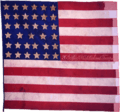 26th Regiment USCT national flag
26th Regiment USCT national flag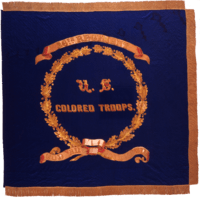 26th US Colored Troops banner
26th US Colored Troops banner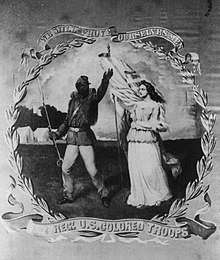 27th US Colored Troops banner
27th US Colored Troops banner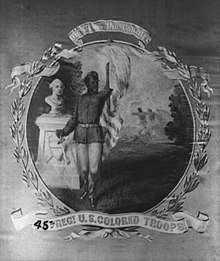 45th US Colored Troops banner
45th US Colored Troops banner
Notable actions
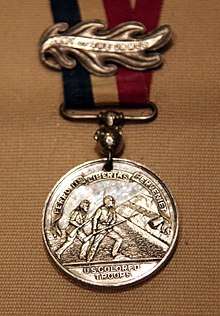
The first engagement by African-American soldiers against Confederate forces during the Civil War was at the Battle of Island Mound in Bates County, Missouri on October 28–29, 1862. African Americans, mostly escaped slaves, had been recruited into the 1st Kansas Colored Volunteers. They accompanied white troops to Missouri to break up Confederate guerrilla activities based at Hog Island near Butler, Missouri. Although outnumbered, the African-American soldiers fought valiantly, and the Union forces won the engagement. The conflict was reported by The New York Times and Harper's Weekly.[15][16] In 2012 the state established the Battle of Island Mound State Historic Site to preserve this area; the eight Union men killed were buried near the battleground.[17]
USCT regiments fought in all theaters of the war, but mainly served as garrison troops in rear areas. The most famous USCT action took place at the Battle of the Crater during the Siege of Petersburg. Regiments of USCT suffered heavy casualties attempting to break through Confederate lines. Other notable engagements include Fort Wagner, one of their first major tests, and the Battle of Nashville.[18]
USCT soldiers were among the first Union forces to enter Richmond, Virginia, after its fall in April 1865. The 41st USCT regiment was among those present at the surrender of the Army of Northern Virginia at Appomattox. Following the war, USCT regiments served among the occupation troops in former Confederate states.
U.S. Army General Ulysses S. Grant praised the competent performance and bearing of the USCT, saying at Vicksburg that:
Negro troops are easier to preserve discipline among than our white troops ... All that have been tried have fought bravely.
— Ulysses S. Grant, at Vicksburg, (July 24, 1863).[19]
Prisoners of war
USCT soldiers suffered extra violence at the hands of Confederate soldiers, who singled them out for mistreatment. They were often the victims of battlefield massacres and atrocities at the hands of the Confederates, most notably at Fort Pillow in Tennessee, at the Battle of the Crater in Virginia,[20] and at the Battle of Olustee in Florida. They were often murdered when captured by Confederate soldiers, as the Confederacy announced that former slaves fighting for the Union were traitors and would be immediately executed.[18]
The prisoner exchange protocol broke down over the Confederacy's position on black prisoners-of-war. The Confederacy had passed a law stating that blacks captured in uniform would be tried as rebellious slave insurrectionists in civil courts — a capital offense with automatic sentence of death.[21][22] In practice, USCT soldiers were often murdered by Confederate troops without being taken to court. The law became a stumbling block for prisoner exchange, as the U.S. government in the Lieber Code objected to such discriminatory mistreatment of prisoners of war on basis of ethnicity. The Republican Party's platform during the 1864 presidential election also condemned the Confederacy's mistreatment of black U.S. soldiers.[23] In response to such mistreatment, Ulysses S. Grant, in a letter to Confederate officer Richard Taylor, urged the Confederates to treat captured black U.S. soldiers humanely and professionally and not to murder them. He stated the U.S. government's official position, that black U.S. soldiers were sworn military men and not slaves, as the Confederacy asserted they were.[24]
Numbers of colored troops by state, North and South
The soldiers are classified by the state where they were enrolled; Northern states often sent agents to enroll ex-slaves from the South. Note that many soldiers from Delaware, D.C., Kentucky, Missouri, and West Virginia were ex-slaves as well. Most of the troops credited to West Virginia, however, were not actually from that state.[25]
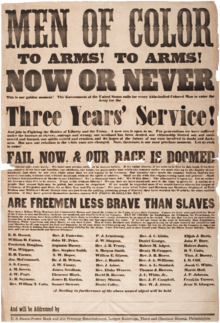
| North[26] | Number | South[26] | Number |
|---|---|---|---|
| Connecticut | 1,764 | Alabama | 4,969 |
| Colorado Territory | 95 | Arkansas | 5,526 |
| Delaware | 954 | Florida | 1,044 |
| District of Columbia | 3,269 | Georgia | 3,486 |
| Illinois | 1,811 | Louisiana | 24,502 |
| Indiana | 1,597 | Mississippi | 17,869 |
| Iowa | 440 | North Carolina | 5,035 |
| Kansas | 2,080 | South Carolina | 5,462 |
| Kentucky | 23,703 | Tennessee | 20,133 |
| Maine | 104 | Texas | 47 |
| Maryland | 8,718 | Virginia | 5,723 |
| Massachusetts | 3,966 | ||
| Michigan | 1,387 | Total from the South | 93,796 |
| Minnesota | 104 | ||
| Missouri | 8,344 | At large | 733 |
| New Hampshire | 125 | Not accounted for | 5,083 |
| New Jersey | 1,185 | ||
| New York | 4,125 | ||
| Ohio | 5,092 | ||
| Pennsylvania | 8,612 | ||
| Rhode Island | 1,837 | ||
| Vermont | 120 | ||
| West Virginia | 196 | ||
| Wisconsin | 155 | ||
| Total from the North | 79,283 | ||
| Total | 178,895 |
Postbellum
The USCT was disbanded in the fall of 1865. In 1867, the Regular Army was set at ten regiments of cavalry and 45 regiments of infantry. The Army was authorized to raise two regiments of black cavalry (the 9th and 10th (Colored) Cavalry) and four regiments of black infantry (the 38th, 39th, 40th, and 41st (Colored) Infantry), who were mostly drawn from USCT veterans. The first draft of the bill that the House Committee on Military Affairs sent to the full chamber on March 7, 1866 did not include a provision for regiments of black cavalry; however, this provision was added by Senator Benjamin Wade prior to the bill's passing.[27] In 1869 the Regular Army was kept at ten regiments of cavalry but cut to 25 regiments of Infantry, reducing the black complement to two regiments (the 24th and 25th (Colored) Infantry).
The two black infantry regiments represented 10 percent of the size of all twenty-five infantry regiments. Similarly, the black cavalry units represented 20 percent of the size of all ten cavalry regiments.[27]
From 1870 to 1898 the strength of the US Army totaled 25,000 service members with black soldiers maintaining their 10 percent representation.[27] USCT soldiers fought in the Indian Wars in the American West, where they became known as the Buffalo Soldiers, thus nicknamed by Native Americans who compared their hair to the curly fur of bison.[28]
Awards
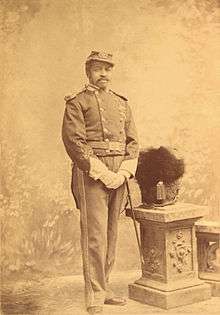
Soldiers who fought in the Army of the James were eligible for the Butler Medal, commissioned by that army's commander, Maj. Gen. Benjamin Butler. In 1861 at Fort Monroe in Virginia, Butler was the first to declare refugee slaves as contraband and refused to return them to slaveholders. This became a policy throughout the Union Army; it started when a few slaves escaped to Butler's lines in 1861. Their owner, a Confederate colonel, came to Butler under a flag of truce and demanded that they be returned to him under the Fugitive Slave Act of 1850. Butler informed him that since Virginia claimed to have left the Union, the Fugitive Slave Law no longer applied, declaring the slaves to be contraband of war.
Sixteen African-American USCT soldiers earned the Medal of Honor, the nation's highest award, for service in the war:[29]
- Sergeant William Harvey Carney of the 54th Massachusetts (Colored) Volunteer Infantry was awarded the Medal of Honor for his actions at the Battle of Fort Wagner in July 1863. During the advance, Carney was wounded but still went on. When the color-bearer was shot, Carney grabbed the flagstaff and planted it in the parapet, while the rest of his regiment stormed the fortification. When his regiment was forced to retreat, he was wounded two more times while he carried the colors back to Union lines. He did not relinquish it until he handed it to another soldier of the 54th. Carney received his medal 37 years after the battle.
- Fourteen African-American soldiers, including Sergeant Major Christian Fleetwood and Sergeant Alfred B. Hilton (mortally wounded) of the 4th USCT, were awarded the Medal of Honor for their actions at the Battle of Chaffin's Farm in September 1864, during the campaign to take Petersburg.
- Corporal Andrew Jackson Smith of the 55th Massachusetts (Colored) Volunteer Infantry was recommended for the Medal of Honor for his actions at the Battle of Honey Hill in November 1864. Smith prevented the regimental colors from falling into enemy hands after the color sergeant was killed. Due to a lack of official records, he was not awarded the medal until 2001.
Legacy
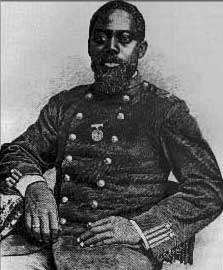
The historian Steven Hahn proposes that when slaves organized themselves and worked with the Union Army during the American Civil War, including as some regiments of the USCT, their actions comprised a slave rebellion that dwarfed all other slave revolts.[30]
The African American Civil War Memorial Museum helps to preserve pertinent information from the period.[31]
Tributes
- In September 1996, a national celebration in commemoration of the service of the United States Colored Troops was held.
- The African American Civil War Memorial (1997), featuring Spirit of Freedom by sculptor Ed Hamilton, was erected at the corner of Vermont Avenue and U Street NW in the capital, Washington, D.C. It is administered by the National Park Service.
- In 1999 the African American Civil War Museum opened nearby.
- In July 2011, the museum celebrated a grand opening of its new facility at 1925 Vermont Avenue, just across the street from the memorial.
Other

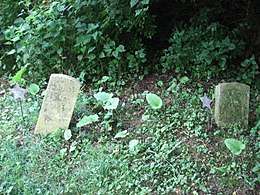
The history of the USCT's wartime contribution was kept alive within the U.S. black community by historians such as W. E. B. Du Bois. Since the 1970s and the expansion of historical coverage of minorities, the units and their contributions have been the subject of more books and movies. During the war years, the men had difficulty gaining deserved official recognition for achievement and valor. Often recommendations for decorations were filed away and ignored. Another problem was that the government would mail the award certificate and medal to the recipient, who had to pay the postage due (whether he were white or black). Most former USCT recipients had to return the medals for lack of funds to redeem them..The last USCT soldier Joseph Clovese died in 1951.[33]
The motion picture Glory, starring Denzel Washington, Morgan Freeman, and Matthew Broderick, portrayed the African-American soldiers of the 54th Massachusetts Volunteer Infantry Regiment. It showed their training and participation in several battles, including the second assault on Fort Wagner on July 18, 1863. Although the 54th was not a USCT regiment, but a state volunteer regiment originally raised from free blacks in Boston, similar to the 1st and 2nd Kansas Colored Infantry, the film portrays the experiences and hardships of African-American troops during the Civil War.[34] Richard Walter Thomas, black scholar of race relations, observed that the relationship between white and black soldiers in the Civil War was an instance of what he calls "the other tradition": "… after sharing the horrors of war with their black comrades in arms, many white officers experienced deep and dramatic transformations in their attitudes toward blacks."[35]
Similar units
- 92nd Infantry Division (United States)
- 93d Infantry Division (United States)
- 366th Infantry Regiment (United States)
- 369th Infantry Regiment (United States)
- 761st Tank Battalion (United States)
See also
Notes
- Rodriguez, Junius P. Slavery in the United States: A Social, Political, and Historical Encyclopedia, ABC-CLIO, 2007, vol. 2, pg 241
- Cornish, The Sable Arm, pp. 29–111.
- Cornish, The Sable Arm, p. 130.
- Okihiro, Gary (2015). American History Unbound: Asians and Pacific Islanders. Oakland: University of California Press. pp. 87–89. ISBN 978-0-520-96030-5.
- Angela Y. Walton-Raji (2008). "Battles Fought in Indian Territory and Battles Fought by I.T. Freedmen outside of Indian Territory". Oklahoma's Black Indians. Retrieved October 24, 2008.
- Cornish, The Sable Arm, p. 288; McPherson, The Negro's Civil War, p. 237
- Herbert Aptheker, "Negro Casualties in the Civil War", "The Journal of Negro History", Vol. 32, No. 1. (January, 1947).
- Cornish, The Sable Arm, p. 218.
- McPherson, The Negro's Civil War, Chapter XIV, "The Struggle for Equal Pay," pp. 193–203.
- Rhea, Gordon C. To the North Anna River: Grant and Lee; May 13–25, 1864; Baton Rouge, LA; Louisiana State University Press, 2000. ISBN 0-8071-2535-0
- Cited by the U.S. National Archives and Records Administration on their website, "The Fight for Equal Rights: Black Soldiers in the Civil War".
- "Colored (African American) Soldier and Family in Civil War Era Photo Identified". Jubilo! The Emancipation Century.
- "The Roanoke Island Freedmen's Colony"; Carolina Country Magazine, date?, accessed November 10, 2010
- This group of mixed-race people were descended generally from male native-born Spanish and French colonists (called Criolla or Créole) and African slave women, or free African-American women. After the United States made the Louisiana Purchase (1803), many Americans moved to Louisiana. They ignored the status of the free people of color, grouping them with the mass of blacks, then mostly slaves. (Today the people of color descended from this group are generally referred to as Louisiana Creoles.)
- "Affairs In The West.; A Negro Regiment in Action – The Battle of Island Mounds – Desperate Bravery of the Negros – Defeat of the Guerrillas – An Attempted Fraud", The New York Times, 19 November 1862, accessed 22 February 2016
- Chris Tabor, "Skirmish at Island Mound", Island Mound website, accessed 12 Oct 2009
- Battle of Island Mound State Historic Site; Missouri Department of Natural Resources
- Cornish, The Sable Arm, pp. 173–80.
- Words of our Hero: Ulysses S. Grant, edited by Jeremiah Chaplin, Boston: D. Lothrop and Company, pp. 13–14.
- Robertson, Jr., JamesI.; Pegram, Willuam (1990). "'The Boy Artillerist': Letters of Colonel William Pegram, C.S.A.". Virginia Magazine of History and Biography. 98 (2 (The Trumpet Unblown: The Old Dominion in the Civil War)). pp. 242–243.
- Williams, George W., History of the Negro Race in America from 1619 to 1880: Negros as Slaves, as Soldiers, and as Citizens, vol. II, New York: G.P. Putnam Son's, 1883, pp. 351–52.
- Congress of the Confederate States of America. "No. 5". Joint Resolution on the Subject of Retaliation. May 1, 1863. Retrieved March 6, 2016.CS1 maint: location (link)
- Republican Party (June 7, 1864). "Republican Party Platform of 1864". Archived from the original on April 21, 2015.
[T]he Government owes to all men employed in its armies, without regard to distinction of color, the full protection of the laws of war—and that any violation of these laws, or of the usages of civilized nations in time of war, by the Rebels now in arms, should be made the subject of prompt and full redress.
- Grant, Ulysses (1863). "Letter to Richard Taylor". Vicksburg.
I feel no inclination to retaliate for the offences of irresponsible persons; but if it is the policy of any General intrusted with the command of troops to show no quarter, or to punish with death prisoners taken in battle, I will accept the issue. It may be you propose a different line of policy towards black troops, and officers commanding them, to that practiced towards white troops. So, I can assure you that these colored troops are regularly mustered into the service of the United States. The Government, and all officers under the Government, are bound to give the same protection to these troops that they do to any other troops.
- 45th United States Colored Troops
- Gladstone, William A., United States Colored Troops, p. 120
- Schubert, Frank N. (1997). Black Valor: Buffalo Soldiers and the Medal of Honor, 1870-1898. Scholarly Resources Inc. pp. 4-5. ISBN 9780842025867.
- "Wild West Western Facts, Buffalo Soldiers". The Wild West. Retrieved December 3, 2015.
- Schubert, Frank N. (1997). Black Valor: Buffalo Soldiers and the Medal of Honor, 1870-1898. Scholarly Resources Inc. pp. 2-4. ISBN 9780842025867.
- Hahn, Steven (2004). "The Greatest Slave Rebellion in Modern History: Southern Slaves in the American Civil War". southernspaces.org. Retrieved August 22, 2010.
- African American Civil War Memorial and Museum; organization website
- "District of Columbia. Company E, 4th U.S. Colored Infantry, at Fort Lincoln". loc.gov.
- Pvt Joseph Clovese 1844-1951
- See film review by historian James M. McPherson, "The 'Glory' Story," The New Republic, January 8 & 15, 1990, pp. 22–27.
- Richard Walter Thomas (January 1996). John H. Standfield II (ed.). Understanding interracial unity: a study of U.S. race relations. Sage series on race and ethnic relations. 16. Sage Publications. p. 31. ISBN 978-0-8039-4602-6.
References
- Cornish, Dudley Taylor. The Sable Arm: Negro Troops in the Union Army, 1861–1865. New York: W.W. Norton, 1965.
- Dobak, William A. Freedom by the Sword: The US Colored Troops, 1862–1867. Washington, DC: Center of Military History, 2011.
- Gladstone, William A. United States Colored Troops, 1863–1867. Gettysburg, PA: Thomas Publications, 1996.
- Johnson, Jesse J. Black Armed Forces Officers 1736–1971. Hampton Publications, 1971.
- Matthews, Harry Bradshaw, African American Freedom Journey in New York and Related Sites, 1823–1870: Freedom Knows No Color, Cherry Hill, NJ: Africana Homestead Legacy Publishers, 2008.
- McPherson, James M., The Negro's Civil War: How American Negroes Felt and Acted During the War for the Union. New York: Pantheon Books, 1965.
- Schubert, Frank N. (1997). Black Valor: Buffalo Soldiers and the Medal of Honor, 1870-1898. Scholarly Resources Inc. ISBN 9780842025867.
- Smith, John David, Lincoln and the U.S. Colored Troops (Southern Illinois University Press, 2013). 156 pp.
- Williams, George W., A History of the Negro Troops in the War of the Rebellion. New York: Harper & Brothers, 1887.
- Film review, James M. McPherson, "The 'Glory' Story," The New Republic, January 8 & 15, 1990, pp. 22–27
Further reading
- The Employment of Negro Troops. By Dr. Ulysses Lee. Published by the Office of the Chief of Military History, United States Army, Washington, D.C., 1966. 740 pp.
External links
| Wikimedia Commons has media related to United States Colored Troops. |